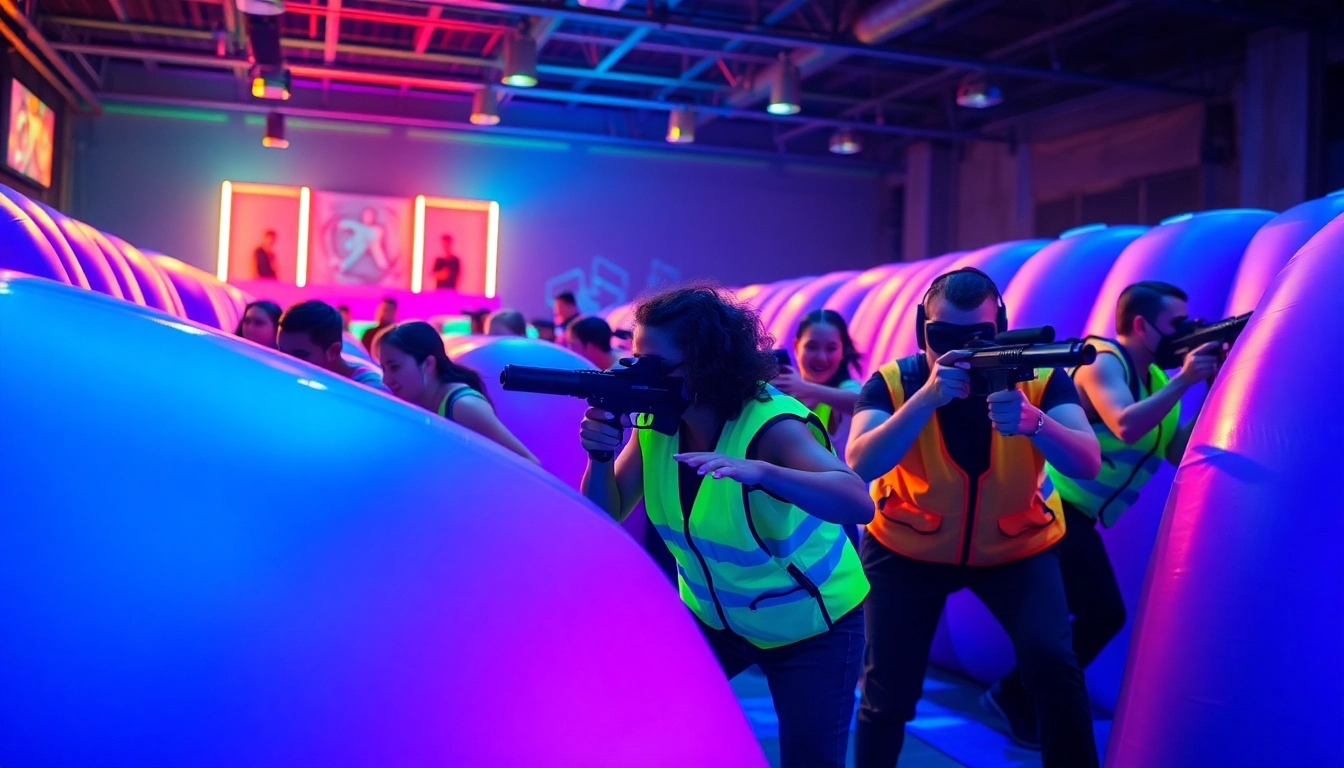Understanding Laser Tag: History and Basics
What is Laser Tag?
Laser tag is an exciting recreational shooting sport where participants engage in combat using infrared-emitting light guns. The objective is to tag opponents or designated targets while adhering to specific gameplay rules that can vary based on the arena settings. Often played in darkened environments with neon lights and various obstacles, laser tag provides a high-energy experience suitable for both children and adults. Players typically wear vests equipped with sensors that detect hits, adding a thrilling technological layer to the game’s mechanics. For those looking to explore the fun of laser tag, understanding its roots and basic gameplay is essential.
History and Evolution of Laser Tag
The origins of laser tag can be traced back to the late 1970s when it was first conceptualized as a form of combat simulation. Inspired by earlier military technology and sci-fi movies, the game started as a complex setup involving infrared shooting systems primarily used in military training. Over the years, this innovative concept evolved into a mainstream recreational activity, with the first commercial laser tag arena opening in 1986 in Dallas, Texas. The modernization of technology has significantly transformed how laser tag is played, incorporating advanced gaming mechanics, diverse themes, and engaging arenas designed to enhance the overall player experience.
Basic Gameplay Rules
Though variations exist based on different game formats and settings, the fundamental rules of laser tag generally include:
- Each player is equipped with a laser tag gun and a vest fitted with sensors.
- The objective is to score points by tagging opponents’ sensors while avoiding being tagged in return.
- Players must adhere to specific time limits, which can vary based on game mode.
- Common game modes include team elimination, capture the flag, and free-for-all.
- Players are encouraged to strategize and communicate with teammates to enhance their chances of winning.
Types of Laser Tag Experiences
Indoor vs Outdoor Laser Tag
Laser tag is played in two primary environments—indoor and outdoor arenas, each offering unique experiences. Indoor laser tag arenas are typically designed with elaborate themes and obstacles, creating a curated environment that immerses players. These venues thrive on low-light conditions to enhance the visual effects of laser beams, creating a mesmerizing combat experience. In contrast, outdoor laser tag offers a more expansive field with natural terrain, allowing for increased movement and tactical gameplay on larger scales. Players may find thrilling strategies differ according to the setting and may require different gear based on environmental factors.
Competitive and Recreational Formats
The laser tag sector accommodates various gameplay styles, appealing to both competitive players and casual enthusiasts. Competitive formats often involve structured tournaments where teams compete for rankings and prizes. These events emphasize strategy, skill, and teamwork, drawing serious players who hone their techniques and communication channels. Recreational formats, on the other hand, are generally more relaxed, focusing on fun and engagement rather than strict competition. This allows participants, regardless of their skill level, to enjoy the game in a friendly, informal atmosphere.
Unique Themes and Storylines
To enhance engagement and excitement, many laser tag venues incorporate unique themes and storylines into their gameplay. These narratives can range from futuristic sci-fi battles to medieval warfare, providing players with immersive experiences that transform combat into an adventure. Players might dress up in costumes reflective of these themes, further enriching the game’s environment and the overall enjoyment for participants.
Essential Gear for Laser Tag
Types of Laser Tag Guns
The equipment used in laser tag has undergone significant advancements, with a wide variety of laser tag guns available to players. Depending on the venue or game type, players may encounter different models, including:
- Pistols: Compact and lightweight, perfect for quick maneuvers and close engagements.
- Rifles: Offering higher accuracy over long distances, these guns allow players to engage opponents from afar.
- Shotguns: These guns cover a wider target area and are effective in close-quarter battles.
Each gun type comes with specific functionalities, such as varying ranges, firing rates, and reload methods, catering to different player preferences.
Protective Equipment and Accessories
In addition to laser tag guns, protective equipment and accessories are crucial for enhancing gameplay and safeguarding players. The most common gear includes:
- Vests: Worn by players to detect hits from opponents, often featuring reinforced padding for comfort and protection.
- Headbands: Some venues offer headbands equipped with sensors, allowing for expanded gameplay mechanics.
- Customizable Accessories: These may include tactical vests or belts with additional gear, helping players strategize and store extra ammo or props.
Choosing the right gear is essential for both comfort and gameplay effectiveness, contributing to a better overall experience.
Choosing the Right Gear for Your Game
Selecting suitable gear for laser tag can significantly influence your enjoyment and performance. Factors to consider include:
- Gameplay Style: Assess whether you prefer aggressive, strategic play or a more casual approach.
- Environment: Indoor games might require different setup and equipment than outdoor ones.
- Group Size: Larger groups may benefit from team-centric gear or enhanced communication tools.
Ultimately, investing time in selecting the right gear can elevate your laser tag experience, ensuring safety and enjoyment.
Strategies for Success in Laser Tag
Teamwork and Communication
Like many team-based games, teamwork and communication are pivotal for success in laser tag. Coordinating with teammates allows players to combine skills and tactics. Effective communication includes verbal cues or hand signals, enabling quick adjustments and strategies during matches. It’s essential to establish set roles within the group, such as scouts and defenders, to maximize efficiency and ensure every player knows their responsibilities.
Movement and Positioning
Player movement and positioning play a critical role in gameplay effectiveness. Staying mobile and using the environment to your advantage can help evade opponents while positioning yourself for strategic attacks. Players should practice varying their movement patterns to avoid becoming predictable to opponents, such as switching from sprinting to crouching to minimize detection. Understanding the layout of the arena also allows players to find advantageous spots for ambushes or cover.
Mastering the Use of Cover
Utilizing cover effectively can greatly increase a player’s odds of success in laser tag. Players should familiarize themselves with obstacles and barriers available within the arena, using them to shield themselves from incoming fire while attempting to tag opponents. Techniques such as peeking from behind cover, using angles to minimize exposure, and constantly relocating are essential skills for maintaining a strategic edge.
Organizing Laser Tag Events
Planning a Birthday or Group Event
Organizing a laser tag event, such as a birthday party or group outing, can be a fantastic way to celebrate while ensuring an unforgettable experience for participants. Planning involves selecting an appropriate venue, considering the number of guests, and deciding on any themes or special requests. Additionally, it’s important to arrange for refreshments and any additional activities or games to keep participants engaged outside of the laser tag matches.
Costs and Logistics
The costs associated with organizing a laser tag event can vary widely based on location, guest count, and specific requests. When planning, ensure to budget for rental fees, gear costs, and any food or beverage needs. Exploring package deals offered by venues can also benefit group events, providing discounts for larger parties. Understanding the logistics involved, such as transportation and game timing, is crucial for a smooth experience.
Promoting Your Laser Tag Event
To successfully gather participants for your laser tag event, effective promotion is key. Utilize social media platforms, flyers, and community boards to spread the word, targeting local audiences. Engaging potential guests with appealing visuals and boosting excitement through sneak previews or theme reveals can enhance interest. Consider offering incentives, such as group discounts or prizes for winners, to encourage participation and foster a competitive spirit.



